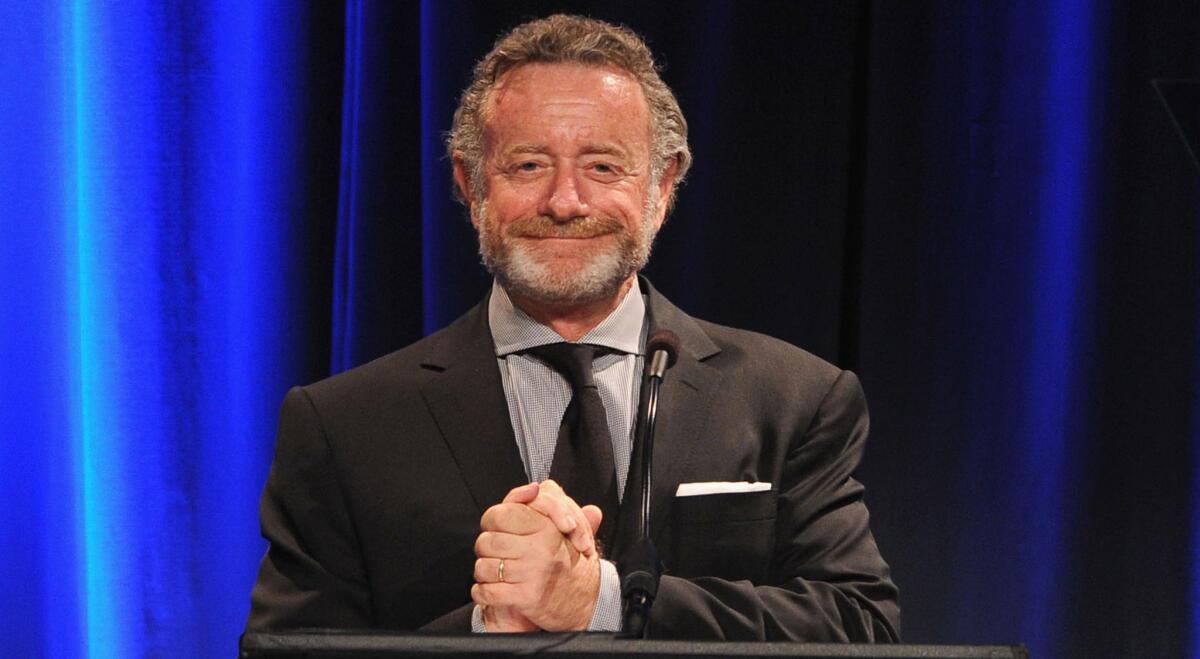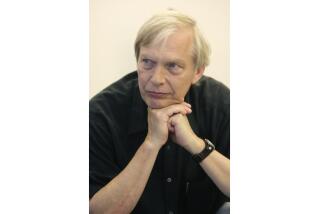NPR president Jarl Mohn is betting on smart, addictive podcasts to hook millennials

- Share via
Will podcasting kill the radio star? National Public Radio President and Chief Executive Jarl Mohn doesn’t think so. The recent ranking from measurement service Podtrac shows that 7.5 million people are listening to NPR’s podcasts each month, making it the most popular supplier of the audio-on-demand programs created for digital devices. But NPR’s listening on traditional terrestrial radio has been trending up as well, with an overall gain of 16% for its signature news magazine programs “Morning Edition” and “All Things Considered” in first quarter of 2016. It’s a reversal for the nonprofit broadcasting service that has watched its audience decline and age in recent years. Mohn, a onetime top 40 disc jockey and former cable executive who took over NPR in 2014, told The Times why he believes podcasts can be the gateway to getting younger listeners hooked on the electronic medium their parents grew up with.
Most new media technologies that come along typically cannibalize the old ones. How does podcasting help NPR?
This is a real additive product. We’re seeing some very encouraging signs that younger people are coming into NPR that previously haven’t listened. They get excited about a podcast and then start listening. We hear versions of the same story – somebody listens to Invisibilia [a podcast series that explores human behavior] and we promote other podcasts heavily in it – some of which might be news. They might shift to the NPR Politics podcast or “The Hidden Brain” and know they can hear its host [science correspondent] Shankar Vedantam on “Morning Edition.” The preliminary data we’re seeing [from Edison Research] is that while [podcasting is growing] there comes a lot of interest from people who have not been listening to public radio at all that are starting to discover us.
But with millennials spending so much time on digital devices, aren’t they listening to less radio in general?
If you look at Nielsen or Edison research data, 92% of millennials listen to the radio every seven days. The average time spent listening over a week is 11 hours and 8 minutes. Twenty years ago they were listening to 12 hours, so they’ve lost an hour and change. It’s down a little. But there is a mythology even in this building that millennials do not listen.
How do you make podcasts appealing to younger listeners who are not heavy consumers of news programming?
Other news organizations have attempted over the years to make very radical changes to their content in an effort to appeal to a younger demographic and in doing so alienated their most loyal and core audience. We’re not going to do that.
The mythology has been that if you want a younger audience it has to be faster paced. Pieces need to be shorter. They have to be exciting. They have to be super well produced. They can’t be about anything substantive. They have to be feature oriented and light.
“Serial” [the multi-part Chicago Public Media podcast about the arrest and trial of Adnan Syed, who was convicted of murdering his ex-girlfriend] and a lot of podcasts have proven that that’s not the case. You can be thoughtful. You can have a great narrative. It doesn’t have to be overly produced. It actually can be a bit slow. The element that really matters is you have to have a great story. That’s why young people are coming to podcasts.
Let’s say I’m a local NPR member radio station that carries your programs. Why shouldn’t I worry that every minute someone listens to an NPR podcast is time not being spent with my station, especially when I’m trying to raise money during pledge drives?
We’re not offering the same content in our podcasts that we do to our terrestrial radio stations. There is some overlap, but it’s really quite small. What we really advocate for member stations is “Morning Edition” and “All Things Considered” – they draw a massive audience in aggregate – 27 million people a week listen to NPR member stations for the news magazines. But we also advocate very strongly that our member stations really focus on being live and being local and cover what’s happening in their markets. Great local journalism mixed with our national and international journalism – you don’t go to a podcast for that. We think that’s the way to compete for the future. Local public radio has started adding local journalists. Nationally across our 264 members stations there are something like 1,600 producers and reporters.
Once you get those listeners to sample NPR on the radio, how do you keep them?
What we’re attempting to do is make sure what we do on terrestrial captures a lot of the sound and the informality of podcasts. On our politics podcasts, we’ve put together younger reporters like Sam Sanders and Tamara Keith working with [veteran NPR correspondents] like Mara Liasson and Ron Elving. And it’s fascinating to hear them talk to one another, because it’s very conversational, very informal and it’s deeply substantive. It’s not being dumbed down, but it lacks the formality you might have heard on NPR. When Mara Liasson and Ron Elving go on the network now, they sound more like they did with Sam and Tamara. I think that’s helped us.
Is that reflected in the ratings?
The demographic that went up the most in the first quarter of 2016 was the 18 to 24 year-olds [average quarter hour listening was up 20% according to Nielsen]. To be fair, it’s not a huge audience. But I point it out because it’s the direction we want to go. It didn’t come at the expense of any of our journalism either.
More to Read
From the Oscars to the Emmys.
Get the Envelope newsletter for exclusive awards season coverage, behind-the-scenes stories from the Envelope podcast and columnist Glenn Whipp’s must-read analysis.
You may occasionally receive promotional content from the Los Angeles Times.











